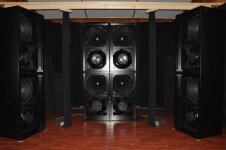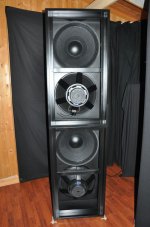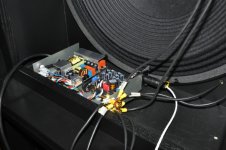Yeah, those are interesting results. Greg, do you have links?
More the latter; power spectral density's a weak function of genre.
Sorry, it appears that the AES link is gone now. It was an excerpt from Floyd Tooles "Sound Reproduction" book, basically summarizing that most listeners in his testing, including trained audio engineers, preferred the sound of a more live room over a more dead room for recreational listening.
I know if you do a search for his book, it will pop up on some questionable sites for free download. Also, check Sean Olives blog for some corroborating information.
Greg
Hi StigErik, very fun thread. Thanks for sharing!
I have a question for you, and any others who have looked into this: is the open backed TPL actually a true di-pole or are BOTH sides generating the same polarity for the pressure wave?
My question arises because of the motion of the pleated accordion driver: never having examined the diaphragm, I am speculating that it may generate simultaneous outward pressure on BOTH sides when the accordion pleats are being "squeezed" together, and simultaneous rarefaction when the pleats are being pulled apart.
If this is the way the AMT driver is operating, then the pressure wave in front and in back would be in phase, and the driver would then create a cylindrical/spherical omni-radially expanding wave, whereas a regular ribbon or planar would be creating a rarefaction in the back when creating a compression in the front.
Could you possibly help determine if this in fact the case? It would be a matter of looking at the impulse polarity on the front vs. the back.
If as I suspect the TPL is more of an omni-radial, the crossover summation on the back side may be radically different from that on the front.
If you or anyone else reading this has the answer to this, it would be great to have confirmation without first having to buy a TPL or Mundorf AMT, taking it apart and only then be able to get the answer!
I have a question for you, and any others who have looked into this: is the open backed TPL actually a true di-pole or are BOTH sides generating the same polarity for the pressure wave?
My question arises because of the motion of the pleated accordion driver: never having examined the diaphragm, I am speculating that it may generate simultaneous outward pressure on BOTH sides when the accordion pleats are being "squeezed" together, and simultaneous rarefaction when the pleats are being pulled apart.
If this is the way the AMT driver is operating, then the pressure wave in front and in back would be in phase, and the driver would then create a cylindrical/spherical omni-radially expanding wave, whereas a regular ribbon or planar would be creating a rarefaction in the back when creating a compression in the front.
Could you possibly help determine if this in fact the case? It would be a matter of looking at the impulse polarity on the front vs. the back.
If as I suspect the TPL is more of an omni-radial, the crossover summation on the back side may be radically different from that on the front.
If you or anyone else reading this has the answer to this, it would be great to have confirmation without first having to buy a TPL or Mundorf AMT, taking it apart and only then be able to get the answer!
Last edited:
I have a question for you, and any others who have looked into this: is the open backed TPL actually a true di-pole or are BOTH sides generating the same polarity for the pressure wave?
You got it wrong - AMT is basically true dipole operation - just search the web, theres lots and lots of schematics about how the pleating actually works - not the least on the manufacturers pages too
...it would be great to have confirmation without first having to buy a TPL or Mundorf AMT, taking it apart and only then be able to get the answer!
Manufacturers would love it
Best
Michael
Taking an AMT apart is not a very big problem though. With the Beyma and Mundorf, the diaphragm can very easily be pulled out, mostly to make it easy to change the diaphragm I guess. I have fried a pair of Mundorf's, but the repair was very easy - pull the old diaphragms and slide in the new ones. Takes less than a minute.
But as Michael says, AMT's are dipoles, so you can save yourself the work. I have measured the impulse response front/rear, and they are out of phase. The polar pattern is also figure-8, like expected from a dipole.
But as Michael says, AMT's are dipoles, so you can save yourself the work. I have measured the impulse response front/rear, and they are out of phase. The polar pattern is also figure-8, like expected from a dipole.
I am exceptionally satisfied with what this big diffusor did with the sound in my room. It was worth all the work and money without a doubt.
Yes stig ....you are now fully certified , congrats and welcome .....
Hi Stig,
Welcome to the linesource Fraternity. I have Full Range Apogee dipoles in our living room, and I have put a few Tall Ficus Benjamina trees behind the speakers to act as diffusers, and have thick drapes on the rear wall behind the listener for absorption of the first wave reflection. I want to put absorbers in the corners of the front wall but cannot in our home. This is the opposite room treatment from your room which has absorption on the front wall and diffusers on the rear wall. My guess is that you want the dipole effect to diminish as the frequency increases.
The Apogee philosophy I was taught: We do not want to significantly attenuate the rear wave of a dipole speaker because by killing off the rear wave with absorption we risk also removing much of the spaciousness and rich sound quality inherent in dipole designs. Diffusion on the front is used to breakup the sound wave and transform it into many smaller diffused waves without killing off the total energy of the original wave. Instead of one single reflected wave reversal, we try to create dozens of smaller wave reversals moving in wide angled departure from the reflection source. We would also like to see this diffusion occur over as broad a band of frequencies as possible.
Agree here , many moons with dipoles and open baffle stuff, best to diffusor front wall behind speakers ...
I agree that a diffused front wall reflection is better than a single strong reflection.
But... personally I care more for that exceptionally precise stereo image, resolution, dynamics and "blackness" you get from no front wall reflection. Yes - a little front wall reflection will sound bigger, but I dont like it. I have worked hard to get it below -30 dB, where its not audible anymore.
But... personally I care more for that exceptionally precise stereo image, resolution, dynamics and "blackness" you get from no front wall reflection. Yes - a little front wall reflection will sound bigger, but I dont like it. I have worked hard to get it below -30 dB, where its not audible anymore.
An externally hosted image should be here but it was not working when we last tested it.
An externally hosted image should be here but it was not working when we last tested it.
cheers Stig,
I hoped that the various depths would be between 4 inches max to 1 inch. There is no way I could disguise that as a funky kind of wall covering, LOL.
I wonder if some of the 3s and 4s could have part of their depth hidden behind the 2s. This would make for a panel around 150mm deep. more complicated, but I might get away with it.
Brad
I hoped that the various depths would be between 4 inches max to 1 inch. There is no way I could disguise that as a funky kind of wall covering, LOL.
I wonder if some of the 3s and 4s could have part of their depth hidden behind the 2s. This would make for a panel around 150mm deep. more complicated, but I might get away with it.
Brad
Ok, here's the last update, and it might be the very last thing I do with this system.
The news are:
Hypex Ncore amps - two driving the RD-75 ribbons, and four driving the woofers - and now there's sixteen of them.... a few pics without front grilles on the woofers below.
The news are:
Hypex Ncore amps - two driving the RD-75 ribbons, and four driving the woofers - and now there's sixteen of them.... a few pics without front grilles on the woofers below.
Attachments
Ok, here's the last update, and it might be the very last thing I do with this system.
The news are:
Hypex Ncore amps - two driving the RD-75 ribbons, and four driving the woofers - and now there's sixteen of them.... a few pics without front grilles on the woofers below.
I can't see the system there are woofers standing in front of it.
The wall of bass.
- Status
- This old topic is closed. If you want to reopen this topic, contact a moderator using the "Report Post" button.
- Home
- Loudspeakers
- Multi-Way
- My open baffle dipole with Beyma TPL-150



